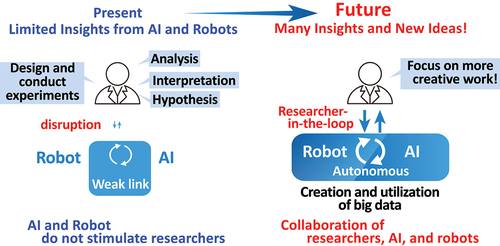Journal:Autonomous experimental systems in materials science
| Full article title | Autonomous experimental systems in materials science |
|---|---|
| Journal | Science and Technology of Advanced Materials: Methods |
| Author(s) | Ishizuki, Naoya; Shimizu, Ryota; Hitosugi, Taro |
| Author affiliation(s) | Tokyo Institute of Technology, The University of Tokyo |
| Primary contact | Email: hitosugi at g dot ecc dot u dash tokyo dot ac dot jp |
| Year published | 2023 |
| Volume and issue | 3(1) |
| Article # | 2197519 |
| DOI | 10.1080/27660400.2023.2197519 |
| ISSN | 2766-0400 |
| Distribution license | Creative Commons Attribution 4.0 International |
| Website | https://www.tandfonline.com/doi/full/10.1080/27660400.2023.2197519 |
| Download | https://www.tandfonline.com/doi/pdf/10.1080/27660400.2023.2197519 (PDF) |
|
|
This article should be considered a work in progress and incomplete. Consider this article incomplete until this notice is removed. |
Abstract
The emergence of autonomous experimental systems (AESs) integrating machine learning (ML) and robots is ushering in a paradigm shift in materials science. Using computer algorithms and robots to decide and perform all experimental steps, these systems require no human intervention. A current direction focuses on discovering unexpected materials and theories with unconventional research approaches. This article reviews the latest achievements and discusses the impact of AESs, which will fundamentally change the way we understand research. Moreover, as AESs continue to develop, the need to think about the role of human researchers becomes more pressing. While ML and robotics can free us from the repetitive aspects of research, we need to understand the strengths and limitations of ML and robots and focus on how humans can perform higher creativity. In addition, we also discuss inventorship and authorship in the era of autonomous systems.
Keywords: autonomous experimental system, closed-loop, machine learning, robots, materials science, inventorship, authorship, human researcher, human’s role
Introduction
The total number of all possible small organic molecules is estimated to be at least 1060[1,2], and from that one can imagine a similarly large number of possible materials being derived using those molecules. This number helps illustrate the vastness of the materials search space, which must contain many materials that can help address current societal problems. In a way, the world of materials is a frontier for exploration, much like space or the deep sea.
How can we quickly and systematically find unexpected materials within this enormous search space? To this end, materials science needs a tool that can transcend the limits of human capabilities to serve as a materials explorer (Figure 1), akin to a spaceship or a deep-sea exploration vessel.
References
Notes
This presentation is faithful to the original, with only a few minor changes to presentation. In some cases important information was missing from the references, and that information was added.










